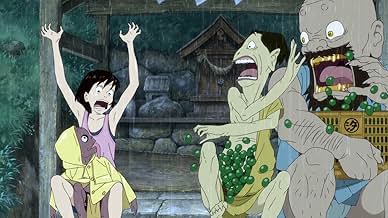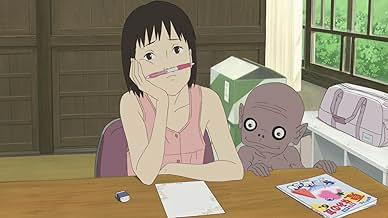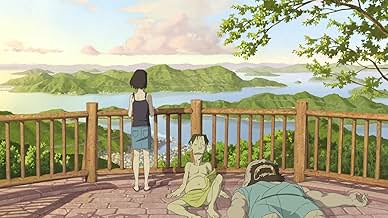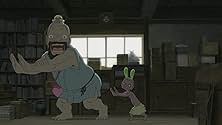Adicionar um enredo no seu idioma11-year-old Momo moves with her mother to a small island town after her father dies. When she arrives, she encounters three goblins that others cannot see who try to help her to cope with th... Ler tudo11-year-old Momo moves with her mother to a small island town after her father dies. When she arrives, she encounters three goblins that others cannot see who try to help her to cope with the loss of her father and the changes in her life.11-year-old Momo moves with her mother to a small island town after her father dies. When she arrives, she encounters three goblins that others cannot see who try to help her to cope with the loss of her father and the changes in her life.
- Prêmios
- 3 vitórias e 7 indicações no total
- Momo Miyaura
- (narração)
- Ikuko Miyaura
- (narração)
- Kazuo Miyaura
- (narração)
- Iwa
- (narração)
- Kawa
- (narração)
- Great Uncle
- (narração)
- Great Auntie
- (narração)
- Koichi
- (narração)
- Umi
- (narração)
- Momo Miyaura
- (English version)
- (narração)
- Ikuko Miyaura
- (English version)
- (narração)
- Kazuo Miyaura
- (English version)
- (narração)
- Iwa
- (English version)
- (narração)
- Kawa
- (English version)
- (narração)
- Mame
- (English version)
- (narração)
- Great Uncle
- (English version)
- (narração)
Avaliações em destaque
Their appearances are reminiscent of "Kyoka Hyakki Yakyo," an illustration of goblins in an Edo-era comic book called "Kibyoshi." "Kibyoshi" is a precursor of 'manga.' In the Edo era, various images of goblins entertained readers and told valuable lessons.
The film is set in Shio Shima, Inland Sea, an allusion to Yasujiro Ozu's classical film "Tokyo Story." Momo moves from Tokyo to the small island after her father's sudden death. While she is boarding a ship, three drops of spirits come down from the sky and land on her. The drops are the goblins or guardians, which help her reconcile a sad memory about her father. She regrets criticizing her father before he passed away.
In the film, the legendary goblins and Momo develop strange but warmhearted relationships that unite the past and present, or this world and afterlife. A motif of connectedness appears at various levels and creates a poignant but cheerful story. First, it shows continuation of time in Japanese popular culture by making a connection with the funny goblins emerging from a "kibyoshi" and in Momo's contemporary life. The past is linked to the present via 'manga.' The emergence of old 'manga'unfolds a history of Japanese popular culture, which intertwines with her daily life and symbolizes continuity.
Second, the connectedness illustrates the relationships between the spirits and humans in a spectacular way. Various types of spirits such as orchard spirits, ocean spirits and forest spirits assist Momo. This is most memorably exemplified when the spirits collaborate to help her in the midst of a fierce typhoon. Thanks to their support, she overcomes a difficulty. Demonstrating collective forces, the animating spirits generate a harmonious and splendid message that life is working with others. Nobody can live alone.
In addition, the scene also gives us a lesson. Each one of the vigorous spirits provides her with a tiny power that is almost negligible, but its contribution is valuable and finally brings a tremendous result to aid her. It reminds us that selfishness and indifference do not bring anything good. The significant message is that everybody has a role to play in the world. The scene is a pivotal moment of her spiritual growth.
Furthermore, the connectedness with the spirits also underlines a powerful animistic note that we are part of nature, which exerts enormous power and is larger than us. Nature and humans can coexist harmoniously in this world. The connectedness is the key that keeps our lives going.
Third, the connectedness demonstrates that death is not the end of life. The goblins have been sent from Above in order to watch over the living. Their special mission is to rally round Momo and report about her life to Above. Their mission expresses a vastness of time in human life, including the afterlife. In short, the dead also have a mission to do in this world. A person's life in this world is finite, but one receives another mission to complete in the afterlife. The amicable relationships between the hilarious goblins and her imply that the deceased can also return to this world and work together with the living. The connection between the dead and the living indicates a culture of ancestor worship, emphasizing the relationships between ancestors and offspring, or the past and present.
Accordingly, the story offers a strong viewpoint that it is possible that we can be befriended by spirits or the deceased. A sense of infinite life is an unforgettably emotional moment and contributes to her psychological relief that she has another chance to make up with her father. Finally, the togetherness ameliorates her hardship. All the connectedness is linked to a process of her reconciliation with her regret.
This film would be particularly appealing for victims of the unprecedented great earthquake and tsunami that struck Japan in 2011. Many people unexpectedly lost their loved ones and everyday lives. They were totally unprepared to suffer such tragedies, let alone time to bid farewell. Later, they left their familiar lands and have been struggling with new environments.
In the film, such sentiments are clearly illustrated. Momo's father had an accident at sea and never returned. Her relocation to Shio Shima is an outcome of the loss of her father. The abrupt loss echoes Japanese collective grief and sorrow for those affected by the unbearable incidents.
Likewise, Momo's struggle is part of their struggle. Her feeling of sadness is theirs; her tears are theirs. Eventually, her achievements foreshadow their hopefulness. The story captures her shuttered heart as a reflection of theirs. It epitomizes Japanese psychology – many people hesitate to talk about their tragedy because it is negative.
The film finally offers a moment of catharsis and kindles a flame of hope. Consequently, underlining the importance of familial bonds and hopes that keep them going toward their future, "A Letter to Momo" is a letter to those victims.
More importantly, the story conveys Japanese Gambaro spirit that is an encouragement for people to work hard. The spiritual essence cultivates a sense of esprit-de-corps and persistence. Gambaro spirit is a sense of working hard together and for others, who will help us sometime and somewhere.
Ultimately, intersecting beings from the afterlife with this world, the film informs us of a traditional belief that invisible spirits live together in this world in order to help us.
All the deceased are our guardians, so chin up!
The film is about a girl named Momo (Japanese for 'Peach'). She and her mother move out to the country from Tokyo after Momo's father's death. Momo hates living there and wants to be back in Tokyo. She also has trouble getting to know the local kids, as she is rather shy. However, over time, three unexpected friends help her out during this time of need--three goblins who are scary looking but who are really quite nice. The problem is that she alone sees them- -and at first she's scared half to death and you cannot blame her! Eventually, however, the four make peace and the rest of the plot is just something you'll need to see for yourself.
So is it any good? Well, as I mentioned above the quality of the production is very nice--really nice animation, lovely music and some cute characters. The story is also lovely--a bit less strange than some of the Miyazaki films (such as "Spirited Away") and it has a very strong Shinto message involving the dead father trying to contact his daughter from the great beyond. Some religious folks might object to this message, but it is very sweet and very Japanese--so what do you expect from a cartoon from Japan?! Well worth seeing...and one that actually might be good to see with a box of Kleenex nearby.
By the way, the DVD I watched was the American version. Often, things are changed or mistranslated in the process and I assume there are some difference between the original and this version. I don't think they would have called these creatures goblins in Japan- -perhaps spirits or demons. Regardless, I just want you to know that my review is based on the Americanized version. Usually, I prefer to see subtitled and original products, not ones redone for local consumption but I oddly had problems getting the DVD to play the Japanese version (which was on the same disc but just wouldn't work on my DVD player).
'A Letter to Momo' is a delightful anime that admittedly is quite a bit like the great 'My Neighbor Totoro', but it feels nothing like an uninspired rehash, in fact I liked this one even a bit better. As far as "substance" goes this is pretty slight but the story here is secondary to the gorgeous animation that feels very alive, every moment is lovingly animated with brilliant attention to detail to movement and the smallest of gestures. It has a captivating, consistent summertime atmosphere to which the rich sound work contributes almost as much as the animation.
This very much starts out as a slice of life drama until the monsters come into play at which point the film becomes really funny. But even though the antics of the creatures are hilarious and those guys are pretty crazy the character of the girl is well-fleshed out and she remains wonderfully real. The third act is mostly a very dramatic tearjerker. If this sounds like the film is all over the place or the tone is inconsistent, it is not. All the elements work together smoothly and it's a well-rounded experience. It is excellently paced but it does take its time and at two hours it might run a bit long. If you are a fan of slice of life anime with supernatural/magical elements this definitely comes highly recommended. Also suitable for your small ones.
This feels like a long lost Studio Ghibli film, as it has a similar to vibe to their chill films like Whisper of the Heart, Only Yesterday, Totoro, etc. The animation is also a similar style to Ghibli in that it has great detail on the facial expressions of the characters and the backgrounds. The story is like a fairy tale that kids could enjoy and get attached to, even if the subject matter can be emotional at times.
You do care for the main character as everyone around her attempts to help her recover. She is also adjusting socially to a new environment that all audiences can connect to.
I'm only docking points because it is still a standard story that has been told many times both in anime and live action. Also, if you are not into films geared towards general audiences and only like mature shows, you can skip this one as well.
I'm glad I checked it out, and its merits a watch if you are a fan of these types of Ghibli-esque dramas.
Você sabia?
- Citações
Momo Miyaura: [last words to her father] You're selfish, and you're a liar. I don't care if you come back.
- Trilhas sonorasUruwashi Mahoroba: Utsukushiki Basho
(Uruwashi Mahoroba: Beautiful Place)
Lyrics & Music by Yûko Hara
Arranged by Jun'ichi Soga & Yûko Hara
Strings Arrangement by Yûko Hara
Performed by Yûko Hara
Principais escolhas
- How long is A Letter to Momo?Fornecido pela Alexa
Detalhes
- Data de lançamento
- País de origem
- Centrais de atendimento oficiais
- Idioma
- Também conhecido como
- A Letter to Momo
- Empresas de produção
- Consulte mais créditos da empresa na IMDbPro
Bilheteria
- Faturamento bruto nos EUA e Canadá
- US$ 71.712
- Fim de semana de estreia nos EUA e Canadá
- US$ 4.596
- 27 de jul. de 2014
- Faturamento bruto mundial
- US$ 6.776.096
- Tempo de duração
- 2 h(120 min)
- Cor
- Mixagem de som
- Proporção
- 1.85 : 1
















